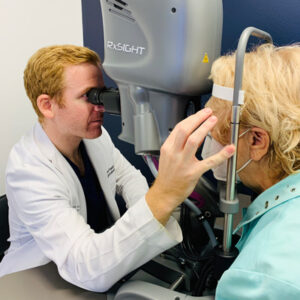Cornea
September 2021
by Ellen Stodola
Editorial Co-Director
The COVID-19 pandemic has had an impact on the screening and use of corneal donor tissue for corneal transplants. Shahzad Mian, MD, Sumitra Khandelwal, MD, and Anthony Aldave, MD, discussed evolving regulations, tissue eligible for use, and more.
One of the first people to identify that COVID-19 was spreading in China was an ophthalmologist. This ophthalmologist was exposed to COVID-19 while managing an asymptomatic patient with glaucoma, became infected with the virus, and died from it, Dr. Mian said. There was concern that there was direct spread from touching the eye, which led to concern about the eye being a vector for transmission of SARS-CoV-2. It also caused concern for corneal transplants.
Infection is always a concern for organ and tissue donation, Dr. Khandelwal said. The Eye Bank Association of America (EBAA) provided several guidelines for ocular tissue recovery. Although testing of the donor for SARS-CoV-2 is not required, a thorough review of the medical chart is conducted and tissue from suspect cases (even if COVID-19 is negative on patient testing) is reviewed by the medical director. There is not much research on the prevalence in ocular tissue because the recommendation is not to recover from donors with confirmed or suspected COVID-19 for the safety of staff, Dr. Khandelwal added, noting that there has been some lab research on SARS-CoV-2 found in ocular tissue.
The decision was made that anyone who died from COVID-19 could not be a donor for corneal tissue, Dr. Mian said. “That has been in place from the beginning, and this has evolved to include that anyone who was exposed to COVID within the last month is not a candidate to be a donor,” he said. There are also criteria relating to if the potential donor was symptomatic. “There was a lot of attention paid to building a system that reduces the risk for recipients,” Dr. Mian said. “Having said that, we don’t actually know if it can be transmitted if someone gets a corneal transplant from a donor who had COVID-19. Though there have been some cases when a recipient has inadvertently gotten donor tissue where the donor was positive for COVID-19, no one has gotten COVID-19 from a transplant that we know of.
“Because we have these certain criteria where we don’t even take tissue from donors who had COVID-19, we’re only looking at donors who could potentially have been asymptomatic and then tested positive,” Dr. Mian said. Looking carefully at data for donors, he said that among those donors who are asymptomatic but tested positive, there is about a 15% risk of having ocular involvement. Similarly, those who were symptomatic but tested negative showed about a 15% chance of having COVID-19 in their eyes.
In a study Dr. Mian participated in,1 investigators found a 13% rate of COVID-19 positivity among potential donors. Then they looked at donors who had exposure but didn’t have any symptoms. “In our study, we found that none of them were positive for COVID-19.”
They also looked at the overall donor pool to identify donors who were thought to be fine (asymptomatic, either not tested or tested early on and were negative). When retested, about 4% were positive for COVID-19. It is possible even to miss some cases when you have criteria for ruling tissue out, he added.
Dr. Mian reiterated that there have not been any confirmed cases of someone getting the virus from a cornea whose donor was COVID-19 positive. Since the beginning of the pandemic, the EBAA has worked to establish detailed criteria for screening that has been reviewed and refined. These criteria incorporated information from the CDC and FDA and were updated as knowledge about the virus increased. The goal, Dr. Mian continued, is to “make sure that we are addressing the concern with risk of transmission from donors who are COVID-19 positive or could be COVID-19 positive,” he said. “But it’s also important to balance the fact that we have patients blind from corneal disease who need their eye surgeries to be able to see.”
Dr. Khandelwal mentioned that evidence has shown that SARS-CoV-2 can be killed with a variety of agents, including betadine. “Ocular tissue, when recovered, goes through a betadine prep, so COVID-19 on the tissue is likely killed,” she said. “However, once again, the recommendation is not to recover COVID-19 positive or COVID-19 suspects, adding a layer of safety for recipients but also for our recovery technicians.”
Evolving recommendations from the EBAA
Dr. Aldave is chair of the EBAA Medical Advisory Board (MAB) Subcommittee that has developed guidelines for eye banks to determine donor eligibility during the pandemic to help ensure the safety of corneal tissues.
The EBAA MAB released their initial guidelines on February 3, 2020. Updated guidelines included a decision table that used the result of reverse transcriptase-polymerase chain reaction (RT-PCR) testing as primary determination of eligibility for ocular tissue donation. Guidelines were further revised with input from eye bank technicians, eye bank medical directors, and others to allow for medical director review for eligibility in the presence of signs and/or symptoms of COVID-19, the existence of a plausible alternative etiology for signs and symptoms, and the absence of close contact with an infected individual. The FDA updated guidelines on Jan. 4, 2021, to say they don’t recommend testing on asymptomatic potential donors, but the donor should be tested if they had specific risk factors.
A recent publication by the EBAA MAB Subcommittee chaired by Dr. Aldave noted that COVID-19 has been a strain on the eye banking system around the world, but screening demands are also a huge burden.2 Testing has been an ongoing issue, whether it’s required or not. Early on, testing was not readily available, and some considered postmortem testing of tissue donors an irresponsible use of these limited testing capacity at the time, he noted. Testing still needs to be approached with caution because there are challenges in interpreting results.
Some results are inconclusive, Dr. Aldave noted, and these donors could not be used because repeat testing isn’t possible. The false positive rate with RT-PCR is relatively low, but donor tissue could be wasted because those who have been infected with COVID-19 may still test positive even though they are not shedding replicating virus. This wasted tissue could impact international supply.
One argument for universal testing was data showing how long the infection lasts postmortem, which could help with a guideline for collecting samples. The EBAA does not require eye banks to perform donor RT-PCR testing for SARS-CoV-2, but other organizations around the world are. Still others advise against it. Dr. Aldave noted that results on postmortem donors could take up to several days, which could delay tissue placement and processing, and universal testing could also increase costs.
Although Dr. Aldave and colleagues have reported eight cases of corneal transplantation using tissue from donors who tested positive for SARS-CoV-2, only one of the recipients developed COVID-19, which was attributed to a community-acquired infection.2 These cases highlight the importance of eye banks establishing a protocol to ensure timely communication with testing agencies about testing notification and results.
COVID-19 has been found in the tear film, and the presence of SARS-CoV-2 viral entry factors have been noted on the ocular surface and in the cornea. Studies have found that it can infect cells in vitro, it remains viable for several days, and it can be found in postmortem tissue.
The current EBAA medical standard requires double exposure of povidone-iodine to the ocular surface before tissue recovery. This is thought to help inactivate infectious virus found on the ocular surface, but it is not known if the virus in deeper tissues remain.
Overall supply of donor tissue
Dr. Mian said that some areas, particularly outside the U.S., are starting to feel the impacts of these more stringent screening guidelines for corneal tissue.
Initially, there wasn’t much of an issue, he said. Through June 2020, the demand was fairly low, as most elective surgeries were canceled, hospitals shut down except for emergency care, and a lot of patients were scared to have surgery, Dr. Mian said. “Although supply decreased, it was still adequate enough to provide care for anyone who needed care through that time.”
Since then, demand has increased as better safety protocols were implemented, he said. “Of course, it’s hard to not provide care for such an extended time period because people who are suffering and not seeing well need their care.”
At this point, Dr. Mian said there is a shortage of supply, even in the U.S. The U.S. is the largest provider of corneal tissue, he added.
Nationally, looking at the EBAA data, it seems like there is still hesitancy for some patients to have surgery, Dr. Mian said, so the demand is at about 85% of what it was prior to COVID-19.
Overall, Dr. Mian said the shortage in tissue is most noticeable globally. Prior to COVID-19, there were 50,000–55,000 corneal transplants per year. “The amount of tissue we could collect was about 85,000, so there was around 30,000 available to export,” Dr. Mian. “It’s drastically reduced globally to many parts of the world where they’re unable to have a good enough system to retrieve corneas on their own.”
Looking forward
Dr. Mian said that there are more studies in this area. “We’re continuing work to look at additional tissue,” he said, noting that his first study looked at around 130 donor tissue samples. “We want to expand to look at more so we can better understand how much tissue involvement there is because perhaps if we have enough data, we can say just because someone is exposed doesn’t automatically mean they can’t be a donor.” That might improve the ability to supply healthy donor tissue to those who need it.
“We’re looking at testing more so we can understand the prevalence better, as well as more safely identify donors who can help recipients,” Dr. Mian. He added that it’s also important to look at how these numbers are impacting overall supply and demand in the U.S. and if there are certain demographics that are impacted more.
About the physicians
Anthony Aldave, MD
Professor of Ophthalmology
Stein Eye Institute
Los Angeles, California
Sumitra Khandelwal, MD
Associate Professor of Ophthalmology
Cullen Eye Institute
Baylor College of Medicine
Houston, Texas
Shahzad Mian, MD
Professor of Ophthalmology and Visual Sciences
Kellogg Eye Center
Ann Arbor, Michigan
References
- Sawant OB, et al. Prevalence of SARS-CoV-2 in human post-mortem ocular tissues. Ocul Surf. 2021;19:322–329.
- Aldave AJ, et al. COVID and the cornea: From controversies to consensus: Report of the Eye Bank Association of America Medical Advisory Board Policy and Position Review Subcommittee. Cornea. 2021;40:809–816.
Relevant disclosures
Aldave: None
Khandelwal: None
Mian: None
Contact
Aldave: aldave@jsei.ucla.edu
Khandelwal: Sumitra.Khandelwal@bcm.edu
Mian: smian@med.umich.edu


